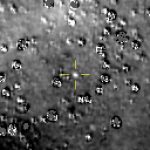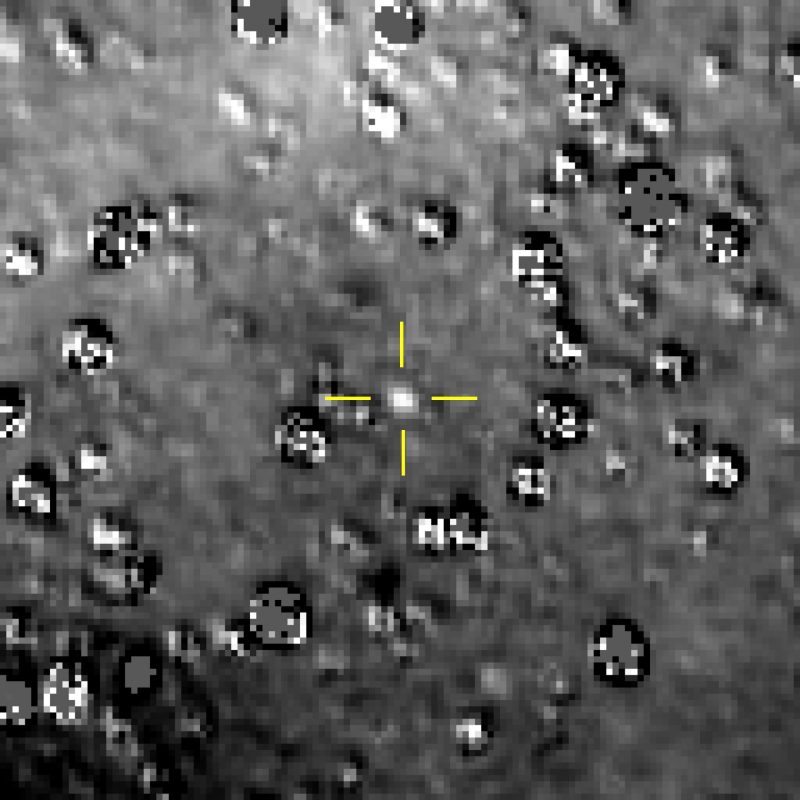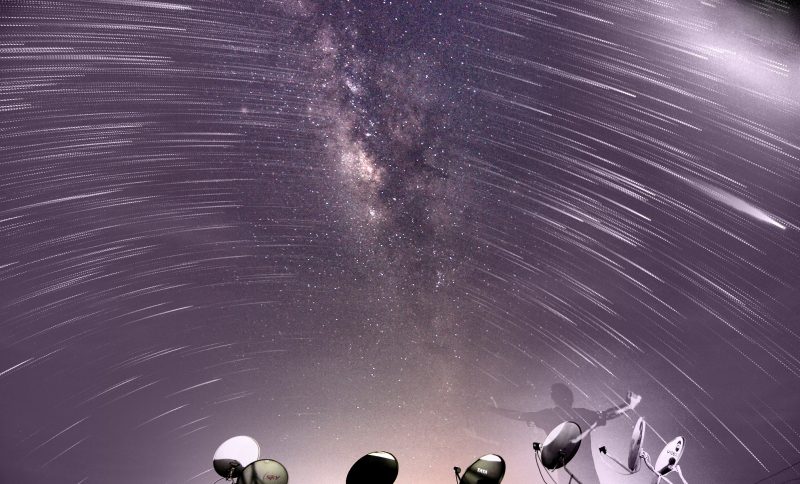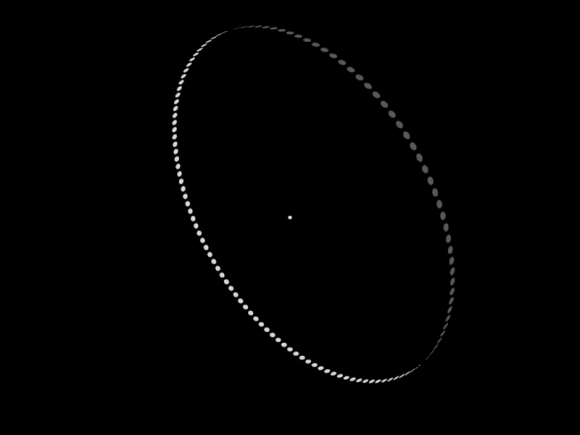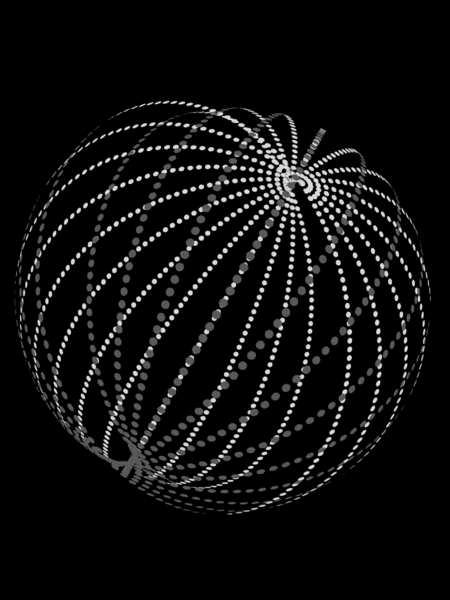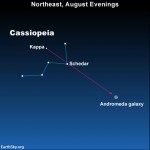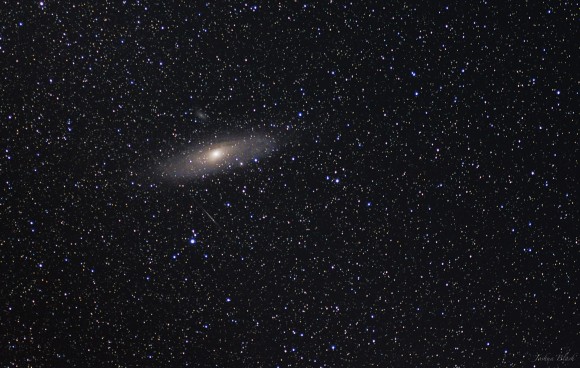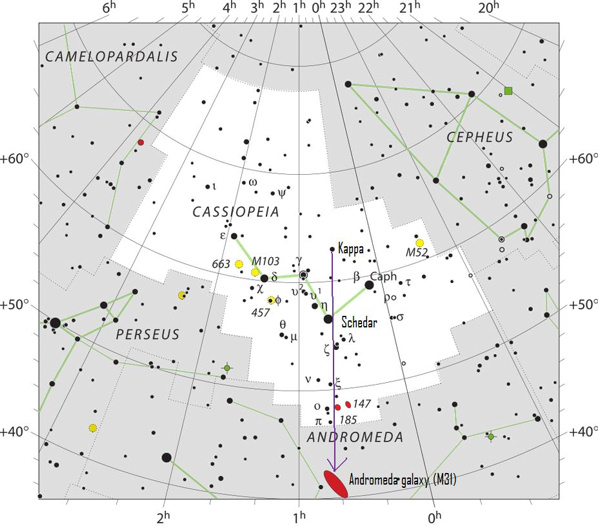

View larger. | Artists’ concept of a Dyson sphere. Notice the little moon or planet on the left side, being ravaged for raw materials. This image – called Shield World Construction – is by Adam Burn. More about it here. Via FantasyWallpapers.com.
When contemplating extraterrestrial intelligence, one of the most tantalizing ideas is that a super-advanced alien civilization could build an enormous structure around its home star, to collect a significant portion of the star’s energy. This hypothetical megastructure is popularly known as a Dyson sphere. It’s a sci-fi-sounding concept, but some scientists have also seriously considered it. This week, a story emerged about how the European Space Agency’s Gaia mission – whose primary purpose is to create a 3D map of our Milky Way galaxy – might be instrumental in the search for Dyson spheres.
In the past, searches for Dyson spheres have focused on looking for signs of excess infrared or heat radiation in the vicinity of a star. That would be a telltale signature, but those attempts have come up empty, so far. The new peer-reviewed study – which was published in the Astrophysical Journal on July 18, 2018, and later described in Astrobites – proposes looking for Dyson spheres with little or no infrared excess. In other words, it describes a technique not attempted before.
Erik Zackrisson at Uppsala University in Sweden led the new study. It focuses on a type of Dyson sphere that would’ve been missed by prior searches focused on infrared radiation.
Suppose you were looking toward a Dyson sphere. What would you see? The visible light of the star would be reduced significantly since the Dyson sphere itself – by its nature – would mostly surround the star for purposes of energy collection. The star would continue shining; it would be shining on the inner portion of the Dyson sphere. Presumably, the star’s radiation would heat the sphere. According to earlier thoughts by scientists on the subject, a Dyson sphere should have a temperature between 50 and 1,000 Kelvin. At that temperature, radiation from the sphere would peak in infrared wavelengths.
That was the earlier idea, until Zackrisson’s study.
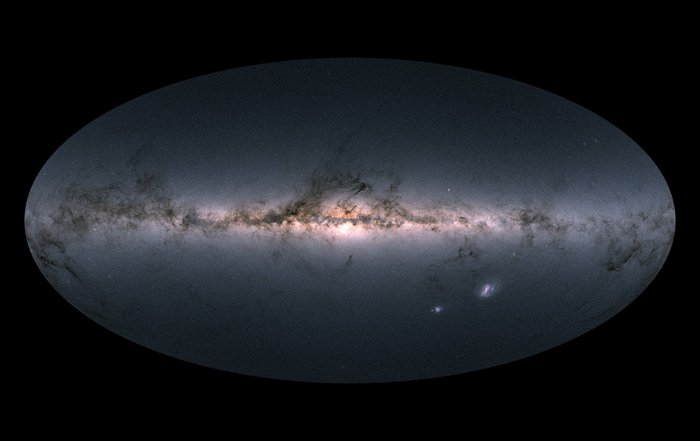
An all-sky view of the Milky Way and neighboring galaxies from the Gaia mission. This view includes measurements of nearly 1.7 billion stars. Image via Gaia Data Processing and Analysis Consortium (DPAC)/A. Moitinho/A. F. Silva/M. Barros/C. Barata – University of Lisbon, Portugal/H. Savietto – Fork Research, Portugal.
His study suggests the possibility that the sphere might be composed of a different kind of material than what had been previously supposed. Suppose this material had the ability to dim the star’s light equally at all wavelengths? That would make it a so-called gray absorber and would significantly affect methods used to search for Dyson spheres. If you measured the star’s distance spectrophotometrically – by comparing the star’s observed flux and spectrum to standard stellar emission models – then the measurements would suggest that the star is farther away than it actually is.
But then if you measured the star’s distance using the parallax method, you’d get a different number. The parallax method compares the apparent movement of a nearby against the star background, as Earth moves from one side of its orbit to another across a period of, say, six months. The size of a Dyson sphere could be determined by comparing the difference in distances between these two methods. The greater the difference, the greater the amount of the star’s surface that is being obscured by the sphere.
Now, thanks to new data from the Gaia mission, astronomers can do these kinds of comparisons, which could – in theory – detect a Dyson sphere. From the new study:
A star enshrouded in a Dyson sphere with a high covering fraction may manifest itself as an optically subluminous object with a spectrophotometric distance estimate significantly in excess of its parallax distance. Using this criterion, the Gaia mission will in coming years allow for Dyson sphere searches that are complementary to searches based on waste-heat signatures at infrared wavelengths. A limited search of this type is also possible at the current time, by combining Gaia parallax distances with spectrophotometric distances from ground-based surveys. Here, we discuss the merits and shortcomings of this technique and carry out a limited search for Dyson sphere candidates in the sample of stars common to Gaia Data Release 1 and Radial Velocity Experiment (RAVE) Data Release 5. We find that a small fraction of stars indeed display distance discrepancies of the type expected for nearly complete Dyson spheres.
In other words, using this new method, astronomers have found candidate Dyson sphere stars.

Graph showing distribution of covering fractions for all stars in the Gaia-RAVE database overlap (left) and just those stars with less than 10% error in their Gaia parallax distance and less than 20% error in their RAVE spectrophotometric distance (right). If the parallax distance is smaller than the spectrophotometric distance, that is interpreted this as a negative covering fraction, and could be an indication of a Dyson Sphere surrounding that star. Image via Zackrisson et al. 2018.
The Gaia mission is currently charting a three-dimensional map of our galaxy, providing unprecedented positional and radial velocity measurements with the highest accuracy ever. The goal is to produce a stereoscopic and kinematic census of about one billion stars in the Milky Way galaxy and throughout the Local Group of galaxies.
As it happens, these data are very useful when searching for Dyson spheres.
Using the parallax distances from the first data release of Gaia, Zackrisson and his colleagues compared that data to previously measured spectrophotometric distances from the Radial Velocity Experiment (RAVE), which takes spectra of stars in the Milky Way. This resulted in an estimate of what percentage of each star could be blocked by Dyson sphere material.
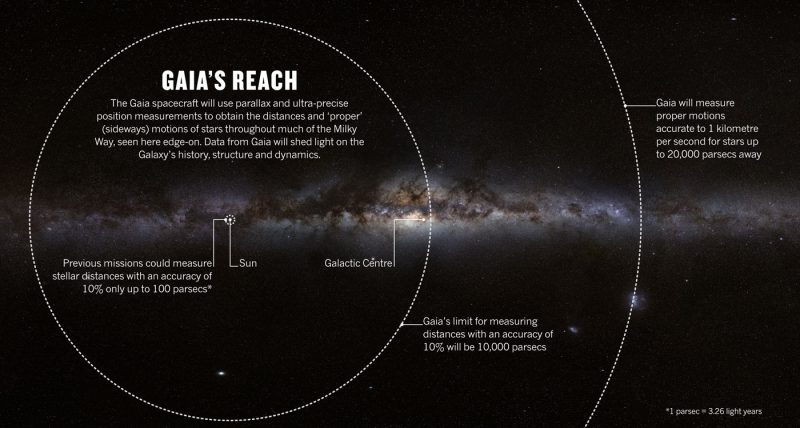
Illustration of how Gaia is measuring the distances to most stars in the Milky Way with unprecedented accuracy. Image via S. BRUNIER/ESO; GRAPHIC SOURCE: ESA.
Of course, figuring out if any of these could actually be Dyson sphere candidates required further analysis. Zackrisson and his team decided to focus on main-sequence stars (like the sun), spectral types F, G and K, and narrowed those down to those which displayed a potential blocking fraction greater the 0.7. Larger giant stars were removed from the data set since their spectrophotometric distances tend to be overestimated compared to main-sequence stars.
This alone left only six possible candidates. Those in turn were then narrowed down to only two, after eliminating four candidates due to problems with the data itself. One of those, the star TYC 6111-1162-1, was then considered to be the best remaining candidate.

Artist’s concept of Gaia in space. Image via D. DUCROS/ESA.
So… has the first Dyson Sphere been found? The simple answer is we don’t know yet. The star, a garden-variety late-F dwarf, seems to exhibit the sought-after characteristics, but more data is needed. No other glitch-related weirdness was found in the data, but the star was also found to be a binary system consisting of two stars (the other being a small white dwarf) which might explain the results, but none of that is certain yet. Additional study of the star will be required, including using future Gaia data releases, to determine what is really happening here. From the new study:
To shed light on the properties of objects in this outlier population, we present follow-up high-resolution spectroscopy for one of these stars, the late F-type dwarf TYC 6111-1162-1. The spectrophotometric distance of this object is about twice that derived from its Gaia parallax, and there is no detectable infrared excess. While our analysis largely confirms the stellar parameters and the spectrophotometric distance inferred by RAVE, a plausible explanation for the discrepant distance estimates of this object is that the astrometric solution has been compromised by an unseen binary companion, possibly a rather massive white dwarf. This scenario can be further tested through upcoming Gaia data releases.
Read more: What is a Dyson sphere?

A handy illustrated guide to Dyson Spheres – massive structures which could be built to surround a star and harness its energy by an advanced alien civilization. Image via Karl Tate/Space.com.
Bottom line: Discovering an actual Dyson sphere, or something similar, would be incredible. This new study proposes a new method of searching which shows some promise. It’s even possible that a Dyson Sphere-type object has already been found in the preliminary data, but that will require more follow-up to either confirm or disprove. Regardless, this new search method will prove valuable in future searches as well.
Source: SETI with Gaia. The Observational Signatures of Nearly Complete Dyson Spheres
Via Astrobites
from EarthSky https://ift.tt/2LFUhes


View larger. | Artists’ concept of a Dyson sphere. Notice the little moon or planet on the left side, being ravaged for raw materials. This image – called Shield World Construction – is by Adam Burn. More about it here. Via FantasyWallpapers.com.
When contemplating extraterrestrial intelligence, one of the most tantalizing ideas is that a super-advanced alien civilization could build an enormous structure around its home star, to collect a significant portion of the star’s energy. This hypothetical megastructure is popularly known as a Dyson sphere. It’s a sci-fi-sounding concept, but some scientists have also seriously considered it. This week, a story emerged about how the European Space Agency’s Gaia mission – whose primary purpose is to create a 3D map of our Milky Way galaxy – might be instrumental in the search for Dyson spheres.
In the past, searches for Dyson spheres have focused on looking for signs of excess infrared or heat radiation in the vicinity of a star. That would be a telltale signature, but those attempts have come up empty, so far. The new peer-reviewed study – which was published in the Astrophysical Journal on July 18, 2018, and later described in Astrobites – proposes looking for Dyson spheres with little or no infrared excess. In other words, it describes a technique not attempted before.
Erik Zackrisson at Uppsala University in Sweden led the new study. It focuses on a type of Dyson sphere that would’ve been missed by prior searches focused on infrared radiation.
Suppose you were looking toward a Dyson sphere. What would you see? The visible light of the star would be reduced significantly since the Dyson sphere itself – by its nature – would mostly surround the star for purposes of energy collection. The star would continue shining; it would be shining on the inner portion of the Dyson sphere. Presumably, the star’s radiation would heat the sphere. According to earlier thoughts by scientists on the subject, a Dyson sphere should have a temperature between 50 and 1,000 Kelvin. At that temperature, radiation from the sphere would peak in infrared wavelengths.
That was the earlier idea, until Zackrisson’s study.

An all-sky view of the Milky Way and neighboring galaxies from the Gaia mission. This view includes measurements of nearly 1.7 billion stars. Image via Gaia Data Processing and Analysis Consortium (DPAC)/A. Moitinho/A. F. Silva/M. Barros/C. Barata – University of Lisbon, Portugal/H. Savietto – Fork Research, Portugal.
His study suggests the possibility that the sphere might be composed of a different kind of material than what had been previously supposed. Suppose this material had the ability to dim the star’s light equally at all wavelengths? That would make it a so-called gray absorber and would significantly affect methods used to search for Dyson spheres. If you measured the star’s distance spectrophotometrically – by comparing the star’s observed flux and spectrum to standard stellar emission models – then the measurements would suggest that the star is farther away than it actually is.
But then if you measured the star’s distance using the parallax method, you’d get a different number. The parallax method compares the apparent movement of a nearby against the star background, as Earth moves from one side of its orbit to another across a period of, say, six months. The size of a Dyson sphere could be determined by comparing the difference in distances between these two methods. The greater the difference, the greater the amount of the star’s surface that is being obscured by the sphere.
Now, thanks to new data from the Gaia mission, astronomers can do these kinds of comparisons, which could – in theory – detect a Dyson sphere. From the new study:
A star enshrouded in a Dyson sphere with a high covering fraction may manifest itself as an optically subluminous object with a spectrophotometric distance estimate significantly in excess of its parallax distance. Using this criterion, the Gaia mission will in coming years allow for Dyson sphere searches that are complementary to searches based on waste-heat signatures at infrared wavelengths. A limited search of this type is also possible at the current time, by combining Gaia parallax distances with spectrophotometric distances from ground-based surveys. Here, we discuss the merits and shortcomings of this technique and carry out a limited search for Dyson sphere candidates in the sample of stars common to Gaia Data Release 1 and Radial Velocity Experiment (RAVE) Data Release 5. We find that a small fraction of stars indeed display distance discrepancies of the type expected for nearly complete Dyson spheres.
In other words, using this new method, astronomers have found candidate Dyson sphere stars.

Graph showing distribution of covering fractions for all stars in the Gaia-RAVE database overlap (left) and just those stars with less than 10% error in their Gaia parallax distance and less than 20% error in their RAVE spectrophotometric distance (right). If the parallax distance is smaller than the spectrophotometric distance, that is interpreted this as a negative covering fraction, and could be an indication of a Dyson Sphere surrounding that star. Image via Zackrisson et al. 2018.
The Gaia mission is currently charting a three-dimensional map of our galaxy, providing unprecedented positional and radial velocity measurements with the highest accuracy ever. The goal is to produce a stereoscopic and kinematic census of about one billion stars in the Milky Way galaxy and throughout the Local Group of galaxies.
As it happens, these data are very useful when searching for Dyson spheres.
Using the parallax distances from the first data release of Gaia, Zackrisson and his colleagues compared that data to previously measured spectrophotometric distances from the Radial Velocity Experiment (RAVE), which takes spectra of stars in the Milky Way. This resulted in an estimate of what percentage of each star could be blocked by Dyson sphere material.

Illustration of how Gaia is measuring the distances to most stars in the Milky Way with unprecedented accuracy. Image via S. BRUNIER/ESO; GRAPHIC SOURCE: ESA.
Of course, figuring out if any of these could actually be Dyson sphere candidates required further analysis. Zackrisson and his team decided to focus on main-sequence stars (like the sun), spectral types F, G and K, and narrowed those down to those which displayed a potential blocking fraction greater the 0.7. Larger giant stars were removed from the data set since their spectrophotometric distances tend to be overestimated compared to main-sequence stars.
This alone left only six possible candidates. Those in turn were then narrowed down to only two, after eliminating four candidates due to problems with the data itself. One of those, the star TYC 6111-1162-1, was then considered to be the best remaining candidate.

Artist’s concept of Gaia in space. Image via D. DUCROS/ESA.
So… has the first Dyson Sphere been found? The simple answer is we don’t know yet. The star, a garden-variety late-F dwarf, seems to exhibit the sought-after characteristics, but more data is needed. No other glitch-related weirdness was found in the data, but the star was also found to be a binary system consisting of two stars (the other being a small white dwarf) which might explain the results, but none of that is certain yet. Additional study of the star will be required, including using future Gaia data releases, to determine what is really happening here. From the new study:
To shed light on the properties of objects in this outlier population, we present follow-up high-resolution spectroscopy for one of these stars, the late F-type dwarf TYC 6111-1162-1. The spectrophotometric distance of this object is about twice that derived from its Gaia parallax, and there is no detectable infrared excess. While our analysis largely confirms the stellar parameters and the spectrophotometric distance inferred by RAVE, a plausible explanation for the discrepant distance estimates of this object is that the astrometric solution has been compromised by an unseen binary companion, possibly a rather massive white dwarf. This scenario can be further tested through upcoming Gaia data releases.
Read more: What is a Dyson sphere?

A handy illustrated guide to Dyson Spheres – massive structures which could be built to surround a star and harness its energy by an advanced alien civilization. Image via Karl Tate/Space.com.
Bottom line: Discovering an actual Dyson sphere, or something similar, would be incredible. This new study proposes a new method of searching which shows some promise. It’s even possible that a Dyson Sphere-type object has already been found in the preliminary data, but that will require more follow-up to either confirm or disprove. Regardless, this new search method will prove valuable in future searches as well.
Source: SETI with Gaia. The Observational Signatures of Nearly Complete Dyson Spheres
Via Astrobites
from EarthSky https://ift.tt/2LFUhes
